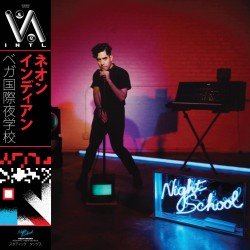 As the mighty Ray Charles once put it, “Night time is the right time.” That feels particularly apt when it comes to certain types of music, as there are some things that just don’t seem right in the bright light of day. Nocturnalists can count on Alan Palomo (a.k.a. Neon Indian), whose third album, Vega Intl. Night School (Mom + Pop Music), seems inspired by what happens when the sun goes down.
As the mighty Ray Charles once put it, “Night time is the right time.” That feels particularly apt when it comes to certain types of music, as there are some things that just don’t seem right in the bright light of day. Nocturnalists can count on Alan Palomo (a.k.a. Neon Indian), whose third album, Vega Intl. Night School (Mom + Pop Music), seems inspired by what happens when the sun goes down.
Palomo has always balanced pop stylings with a sense of experimentation, but Night School is a manifestation of his ambition. While his first album, 2009’s Psychic Chasms, was delightfully washed in homespun lo-fi splendor, the follow up, Era Extrana, was polished but also a sprawling and psychedelic experience. Now, after a four-year absence, Palomo has focused his love for experimentation while at the same time shaping his songs into pop jams. One could attribute this tack to having extra time to craft the album, or maybe, as the title seems to indicate, it was simply a matter of deciding to overtly fuse what he’s been up to with Vega with Neon Indian. Whatever the reason, Night School feels like it has always been hiding in the DNA of the previous two albums.
The album is fairly heavily indebted to the ‘80s, not just in the use of analog synths and digital drums, but in the approach to the sampling. Additionally, there are some nods to freestyle, ’80s R&B, and reggae by way of The Police and Culture Club, but those influences are filtered through another sensibility altogether. A prime example is “Baby Eyes,” which starts out as a smooth loverman throwdown before detouring into a jagged guitar and synth workout in the outro. It sets the stage for “C’est La Vie (Say the Casualties),” which is out of step with the R&B flavor of the preceding songs, but inline with older Neon Indian. It’s like a tip of the cap to longtime fans.
Still, it seems like Palomo plays it safe on the first half of the album, not going too far afield from his previous work, before he decides to go all in on “The Glitzy Hive.” It’s a pretty canny move, and he gets props for melding the various sensibilities into a cohesive whole. The thrilling conclusion of what could be considered Neon Indian’s “Synth Trilogy,” Night School is the sound of a thousand nightclubs that seem to exist only in movies from the ’80s or in a New York that has never known EDM. Whether this is the end of one phase or the start of something new, Neon Indian has managed to craft something wholly unique.

Your Comments